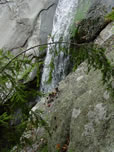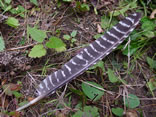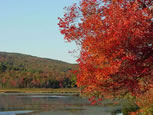
Nature Journal
| |
||
| Sunday, October 13, 2002 | ||
| Yesterday
morning I saw a whitetail doe browsing in the clearing below my house.
I noticed that she had molted into her winter coat. During the summer, the white-tailed deer have a reddish-brown coat. In the late summer or early autumn they molt into their winter coat of grayish brown, which consists of short hairs underneath and longer guard hairs. This coat can be up to 2 inches thick and provides the extra insulation the deer need in the winter. |
||
| Saturday, October 12, 2002 | ||
 This
is a photo of one section of a waterfall in this area. The water is
extremely clear and the rocks are beautiful. This
is a photo of one section of a waterfall in this area. The water is
extremely clear and the rocks are beautiful.Here's another photo of a very pretty area above the main falls where there are shallow pools of water and another tiny waterfall. Areas like this are good habitat for the Louisiana waterthrush, which prefers |
||
| woodlands near clear flowing water. | Click to enlarge | |
| Friday, October 11, 2002 | ||
| Saw
a flock of juncos and tree
sparrows near my house yesterday. They were busily feeding on
the ground and searching the raspberry bushes for the few berries
that are left. Most years, I start seeing a lot of juncos in the fall and then I see them again when I put the bird feeders out (around December 1). Last year was different. There were a lot of juncos passing through this area in the fall, but I didn't see much of them at the feeder during the winter. We'll see what this year brings. |
||
| Thursday, October 10, 2002 | ||
 Here's
a picture of a feather I found recently. It's the wing feather from
a wild turkey. And here's a wild turkey's tail
feather. Here's
a picture of a feather I found recently. It's the wing feather from
a wild turkey. And here's a wild turkey's tail
feather.During the late summer and early fall, the wild turkey gradually goes through a full molt (a replacement of |
||
| its feathers). | Click to enlarge | |
| Wednesday, October 9, 2002 | ||
| The
monarch butterfly
migration is still in progress. Saw one myself a few days ago - feeding
on an aster. Here's a map showing where the monarch butterflies have been seen over the past six weeks or so. Click on any circle that has a black dot to see the written report for that sighting. This map also shows the area where the monarchs overwinter in Mexico. |
||
| Tuesday, October 8, 2002 | ||
 We're
beginning to see more fall foliage color here in southern Vermont.
The leaves on some trees are turning red and yellow, many are still
green, and some are brown - or the leaves have already dropped. We're
beginning to see more fall foliage color here in southern Vermont.
The leaves on some trees are turning red and yellow, many are still
green, and some are brown - or the leaves have already dropped. |
||
| They say that the best foliage color is coming soon. I hope they're right. With this New England weather, you never know what to expect. | Click to enlarge | |
| Monday, October 7, 2002 | ||
| Lately,
the chipmunks have been making
their "chip, chip, chip" sound all day long - except on
rainy days. It is thought that the "chip" sound is a territorial
sound, but it might have other meanings also. Not sure why they'd be "chipping" more now than usual. Maybe because they are competing for the acorns that they're gathering for the winter?? The chipmunks will soon disappear into their burrows until spring. They spend most of the winter in a state of torpor, but wake up from time to time to eat some of their stored food. They will occasionally come outside on a warm day in late winter, only to disappear again when the weather gets colder. Their sounds are a constant part of my environment during the spring, summer, and early fall. So I miss them when they retreat to their dens and am always glad to see them emerge again in the spring. |
||
| Top of page | ||
|
|
| Birds | Butterflies | Mammals |
| Garden Shop |
New England:
Connecticut, Maine, Massachusetts, New Hampshire, Rhode Island, Vermont